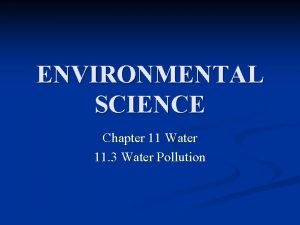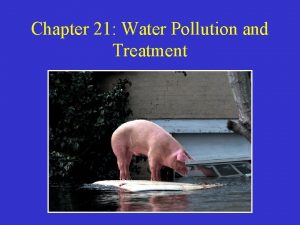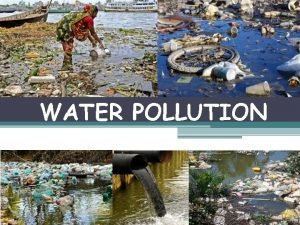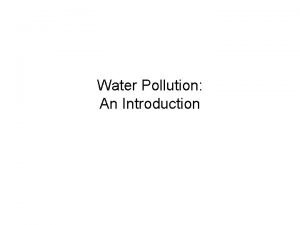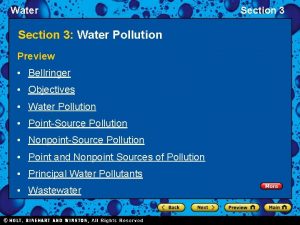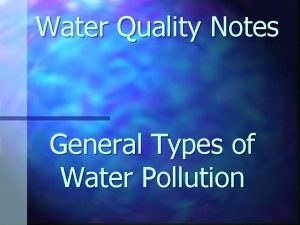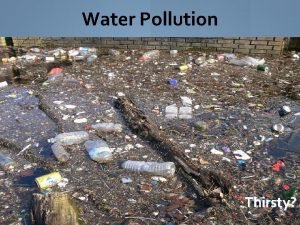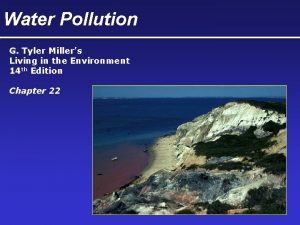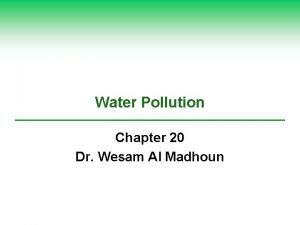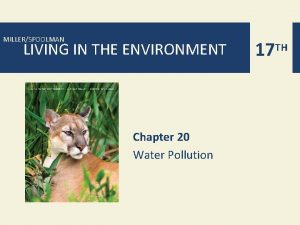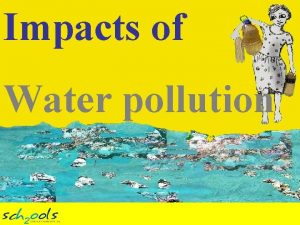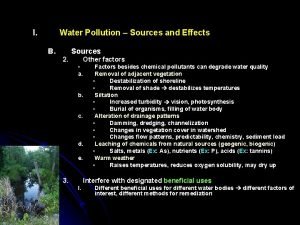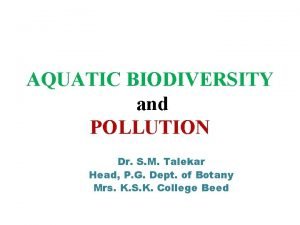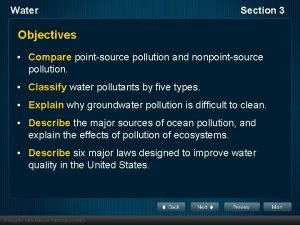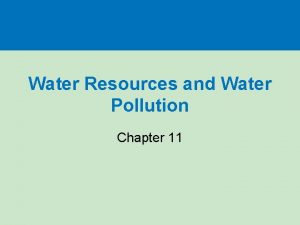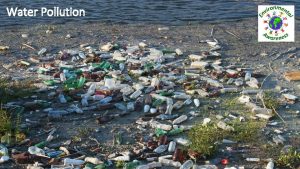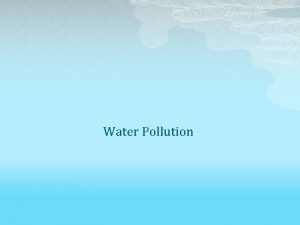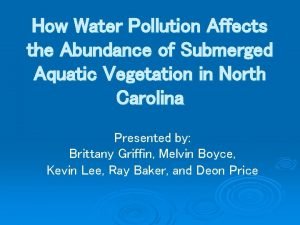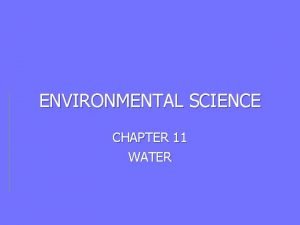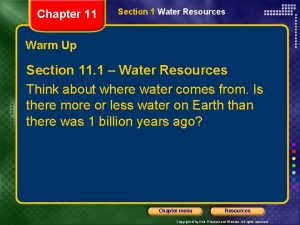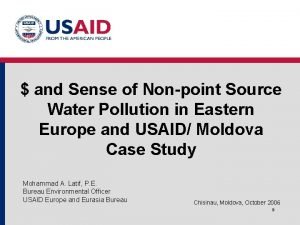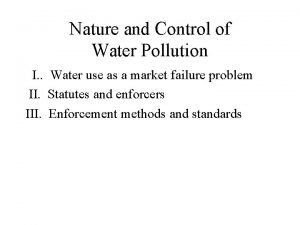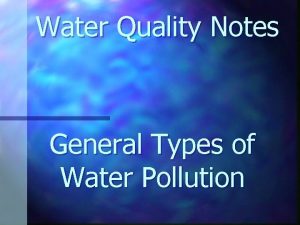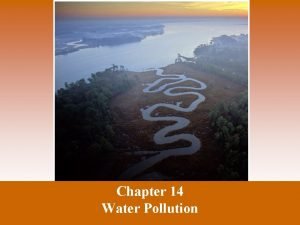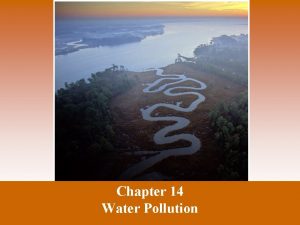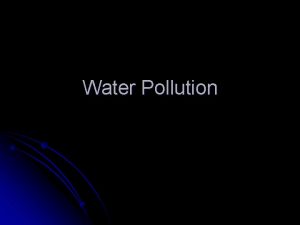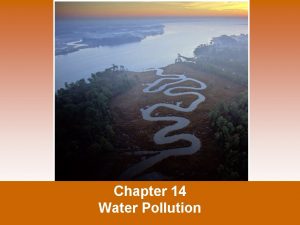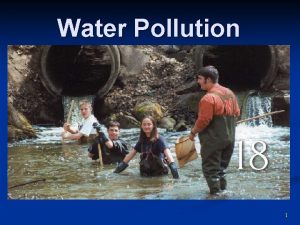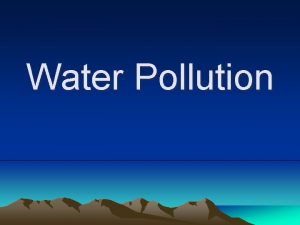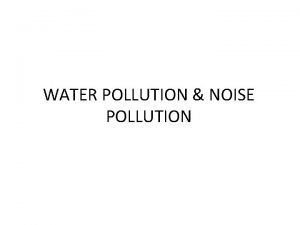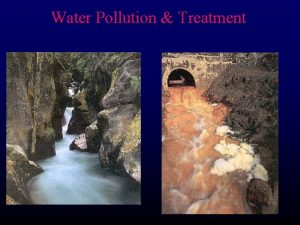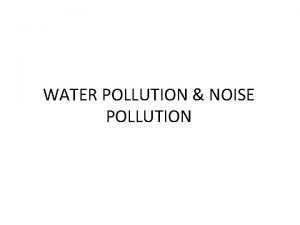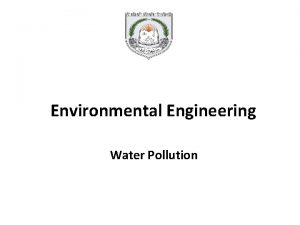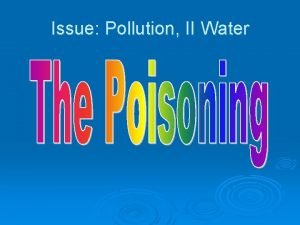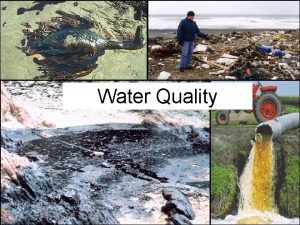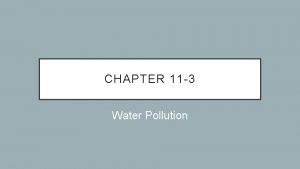Water Pollution An Introduction Outline of Topics The
































- Slides: 32

Water Pollution: An Introduction

Outline of Topics • The Hydrosphere – Water Reservoirs – Water Usage in the US – The Hydrologic Cycle • Composition of the Hydrosphere – The Dissolution Process – Composition of Seawater – Composition of Rivers • Water Pollution – – Changes in River Composition Westhampton Lake Water Pollution Overview: Sources, Pollutants US Water Quality

The Hydrosphere • Lecture Question – List the major water reservoirs on Earth – ie, the components of the hydrosphere – in order of volume (largest to smallest).

US Freshwater Usage Sources of freshwater • approx 75% surface water • approx 25% ground water Uses of freshwater • agriculture (41%) • hydro power (39%) • drinking/washing/etc (12%) • almost half (48%) supplied by ground water • industrial/mining (8%) Largest Consumption • agriculture, by far (85%)

The Hydrologic Cycle • Questions – What is the hydrologic cycle? • The hydrologic cycle is the movement of water between its reservoirs, on either a local or global scale. – What are the processes by which water circulates between its reservoirs? • • Precipitation Condensation Evaporation Transpiration – Uptake from soil by plants, release as vapor from stomata • Overland flow – Surface runoff – Channel flow • Groundwater flow – Baseflow recharges surface water (rivers, lakes, etc) • Infiltration into the soil – Mechanism of groundwater recharge

The Hydrologic Cycle

Global Water Balance and Circulation Volumes: km 3 Fluxes: km 3/yr

Global Water Balance and Circulation • Globally: a giant distillation – There is a net global movement of water • ocean atmosphere land oceans – This process concentrates solutes in oceans that were picked during flow over/through the land • What happens to water that falls (as precipitation) on the land? – Can be intercepted by foliage • Most of this evaporates back into the air – Can run off over land into a nearby river/lake – Can penetrate into the ground (infiltration/recharge) • Soil water: some of this is taken up by roots and transpired back into the air; some is evaporated (evapotranspiration) • Ground water: flows underground towards nearby rivers/lakes (base flow) – Runoff vs infiltration/recharge • Depends on the vegetation/landscape and the rate of precipitation

Fate of Atmospheric Precipitation

Dissolution of Solids • Question – What is a solution? How is it formed? – Electrolytes vs nonelectrolytes – Dissolution of solids • Molecular compounds • Ionic compounds

Composition of the Hydrosphere • Lecture Question – What are the most concentrated solutes in the hydrosphere? – Cations: Na+, K+, Ca 2+, Mg 2+ – Anions: Cl-, SO 42 -, H 2 CO 3/HCO 3 -/CO 32– Neutral: Si(OH)4

Dissolved Solutes in Seawater • Proportions are by mass fraction • Proportions remain fairly constant, even as salinity changes • Ranges of salinity: 33 – 37 g/kg

Dissolved Solutes in Seawater

Dissolved Solutes in Rivers Values from 1980

Dissolved Solutes in Rivers • Concs can be quite variable. • 98% of all rivers have Ca 2+ and HCO 3 - as the principal ions.

Change in Average River Water Composition (Major Ions) • Increases in concentrations of major ions in freshwater due to pollution: – – – – • Ca: +9% Mg: +8% Na: +28% K: +7% Cl: +30% SO 4: +50% (approx) HCO 3: +2% Why? – Irrigation • Mimics “distillation” process (which causes oceans to be salty) on a local scale • Water – often from underground – with dissolved solutes is applied to crops. Some evaporates, concentrating the salts in the soil. These (especially the more mobile ions, such as Na+ and Cl-) make their way back into local rivers. – Atmospheric acid deposition • SO 2 emissions will be oxidized in the atmosphere and deposit as sulfate PM.

Water Pollution • What is wrong with Westhampton Lake? – Pathogens • High counts of fecal coliform (human, animal) – Cultural eutrophication • Due to nutrient pollution – Nitrogen: nitrate, ammonium – Phosphorus: phosphate • Harmful effects – – – Oxygen depletion Siltation Decreased light penetration Increased mobility of toxic metals Increased production of methane, hydrogen sulfide, other noxious gases

Classification of Water Pollution • Biological pollution – Pathogens (poor sanitation) – Others: invasive species, eutrophication, etc • Physical pollution – Thermal pollution (water used as coolant) – Siltation (increased TSS), eg due to increased erosion • Chemical pollution – Change in chemical composition and toxicity

Water Pollution Overview • Worst Water Pollution Problems – Pathogens • Due to poor sanitation • Can be a serious problem in developing countries • WMO estimate: 3. 5 million die a year from water-born disease, mostly children under 2 years old – Nutrient pollution • Causes cultural eutrophication, algae blooms, oxygen depletion – High BOD waste • Causes oxygen depletion – Toxic metals • Sometimes called “heavy” metals • Lead, mercury, arsenic are the worst offenders – Toxic organics • Pesticides, petroleum by-products, solvents, industrial waste, etc

Major Activities that Pollute the Hydrosphere • Industrial discharges – eg, paper and pulp mills, chemical manufacturers, steel plants, textile manufacturers, food processing plants • Sewage discharges – Discharges of treated sewage from treatment plants; combined sewer overflows (CSOs) • Urban runoff – Runoff from impervious surfaces (streets, etc) • Agricultural operations – Crop production, livestock operations (esp cafos) • Silvicultural operations – Forest management, tree harvesting, logging road construction • Resource extraction – Mining, petroleum drilling, runoff from mine tailing sites • Waste disposal – Landfill leachate, underground injection, incineration (followed by atmospheric deposition of pollutants) • Hydrologic modification – Channelization, dredging, dam construction, removal of riparian vegetation, streambank modification, drainage/filling of wetlands

Water Pollution Summary

US Water Quality • Classification – Good • Water quality is sufficient to meet all designated uses – Impaired • Water quality is insufficient to meet at least one designated use • State obligated to develop “TMDL” rules for impaired water bodies • Some Designated Uses (varies by state) – Food supply • Fish consumption • Shellfish consumption – Water supply • Public drinking water • Agricultural (irrigation) – Recreation • Swimming (primary contact) • Boating (secondary contact) – Ecosystem health • Aquatic life support • Wildlife support

US Water Quality: Common Causes of Impairment

Water Quality in the US (2000): Rivers and Streams • Overall impairment level – • Leading Polluting Sources 1. 2. 3. 4. 5. • 39% of rivers and streams are impaired for their designated use Agriculture Hydrologic Modification Urban Runoff Forestry Sewage Discharges Leading Pollutants/Stressors 1. 2. 3. 4. 5. Pathogens Siltation Habitat Alterations High BOD Nutrients

Water Quality in the US (2000): Lakes, Reservoirs, Ponds • Overall impairment level – • Leading Polluting Sources 1. 2. 3. 4. 5. • 45% of lakes, reservoirs, and ponds are impaired for their designated use Agriculture Hydrologic Modification Urban Runoff Unspecified Point Sources Atmospheric Deposition Leading Pollutants/Stressors 1. 2. 3. 4. 5. Nutrients Toxic Metals Siltation TDS (ie, high salinity) High BOD

Water Quality in the US (2000): Estuaries • Overall impairment level – • Leading Polluting Sources 1. 2. 3. 4. 5. • 51% of estuaries are impaired for their designated use Sewage Discharges Urban Runoff Industrial Atmospheric Deposition Agricultural Leading Pollutants/Stressors 1. 2. 3. 4. 5. Toxic Metals Pesticides High BOD Pathogens Toxic Organics

Water Quality in the US (2000): Great Lakes • Overall impairment level – • Leading Polluting Sources 1. 2. 3. 4. 5. • 78% of Great Lakes Shoreline waters are impaired for their designated use Contaminated Sediments Urban Runoff Agricultural Atmospheric Deposition Habitat Modification Leading Pollutants/Stressors 1. 2. 3. 4. 5. Toxic Organics Nutrients Pathogens Siltation High BOD

Virginia Water Quality

VA Water Quality • Leading causes of impairment – Rivers • • Major: Pathogens (fecal coliform, e coli) Others (minor): DO, p. H, freshwater benthics, PCBs in fish – Lakes 1. DO 2. PCBs in fish – Estuaries (Chesapeake) 1. PCBs in fish 2. DO 3. Benthics (more minor)

VA Water Quality Trends

VA Chesapeake Bay: Oxygen Depletion

VA Chesapeake Bay: Submerged Aquatic Vegetation • SAV goal: 77, 463 acres – 37, 640 acres attained – 38, 823 acre shortfall
 Water and water and water water
Water and water and water water Introduction of water pollution
Introduction of water pollution Introduction of water pollution
Introduction of water pollution Water pollution introduction
Water pollution introduction Industrial waste causes
Industrial waste causes Pollution topics
Pollution topics In an outline the relationship of topics
In an outline the relationship of topics Sandwich sentences
Sandwich sentences Sources of groundwater pollution
Sources of groundwater pollution Explain water pollution
Explain water pollution Type of reefs
Type of reefs Solution for water pollution
Solution for water pollution What are the terrible twelve water pollution
What are the terrible twelve water pollution Solutions to water pollution
Solutions to water pollution 2 causes of land pollution
2 causes of land pollution 8 effects of water pollution
8 effects of water pollution Soil pollution images diagram
Soil pollution images diagram How to reduce water pollution
How to reduce water pollution Effects of water pollution
Effects of water pollution Ddt water pollution
Ddt water pollution What are 5 effects of water pollution?
What are 5 effects of water pollution? Aims and objectives of water pollution
Aims and objectives of water pollution We can reduce water pollution
We can reduce water pollution Conclusion of water pollution
Conclusion of water pollution Types of water pollution
Types of water pollution Why is water pollution a great concern in southwest asia
Why is water pollution a great concern in southwest asia Summary of water pollution
Summary of water pollution Environmental science chapter 11
Environmental science chapter 11 Control measures of water pollution
Control measures of water pollution Chapter 11 section 3 water pollution answer key
Chapter 11 section 3 water pollution answer key Observation water pollution
Observation water pollution Site:slidetodoc.com
Site:slidetodoc.com High level of pollution
High level of pollution

